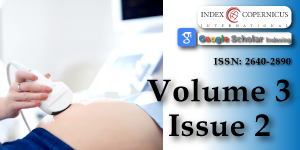The influence of HBV or HCV infections on the pregnancy course
Main Article Content
Abstract
The incidence of HBV infections among the pregnant in Europe falls within the range of 1% - 7%, whereas it is 1.7% - 4.3% for HCV.
The aim was to assess the course of pregnancy among women infected with HBV or HCV, and the condition of neonates in the fifth minute after the birth.
The study included 157 pregnant individuals infected with HBV, 53 infected with HCV, and 330 healthy pregnant women. None of the women infected with HBV and HCV as well as from the control group were infected with HIV, and none of them took intoxicants.
Weight of neonates delivered by healthy women was higher as compared with children born by women infected with HBV or HCV (3,517 vs. 3,347 and 3,366). The Apgar score of neonates delivered by women with HBV and HCV infections was lower as compared with the children born by healthy women (9.4 vs. 9.3 vs. 9.7; p < 0.05). Premature births occurred more often in HBV and HCV-infected women than in the control group (14.6% and 24.5% vs. 6.96%; p < 0.05). Miscarriages were significantly more common among the pregnant with HCV infections as compared with the pregnant who were healthy (9.4% vs. 1.8%; p < 0.05). In comparison with the healthy individuals, this group of patients experienced pruritus (10.5% vs. 4.2%; p < 0.05), oedemas (9.4% vs. 2.4%; p < 0.05), and hypertension (9.4% vs. 1.5%; p < 0.05) more often.
An increase in HBV loads was observed between the 6th and 28th – 32nd week of pregnancy among the infected with HBV, and then, a decrease was observed in the 6th months after the delivery.
The pregnant infected with HBV without HBsAg (-) and the infected with HCV are subject to common incidence of premature births. Women infected with HCV often experience oedemas, hypertension, and pruritus.
Article Details
Copyright (c) 2020 Lapiński TW.

This work is licensed under a Creative Commons Attribution 4.0 International License.
Jonas MM. Hepatitis B and pregnancy: an underestimated issue. Liver Int 2009: 133-139. PubMed: https://pubmed.ncbi.nlm.nih.gov/19207977/
Komatsu H, Inui A. Hepatitis B virus infection in children. Expert Rev Anti Infect Ther. 2015; 13: 427-450.
European Association for the Study of the Liver. EASL 2017 Clinical Practice Guidelines on the management of hepatitis B virus infection. J Hepatol. 2017; 67: 370-398.
Patton H, Tran TT. Management of hepatitis B during pregnancy. Nat Rev Gastroenterol Hepatol. 2014; 11: 402-409. PubMed: https://pubmed.ncbi.nlm.nih.gov/24686270/
Cui AM, Cheng XY, Shao JG, Li HB, Wang XL, et al. Maternal hepatitis B virus carrier status and pregnancy outcomes: a prospective cohort study. BMC Pregnancy Childbirth. 2016; 26; 16: 87. PubMed: https://pubmed.ncbi.nlm.nih.gov/27113723/
Ayoub WS, Cohen E. Hepatitis B Management in the Pregnant Patient: An Update. J Clin Transl Hepatol. 2016; 4: 241-247. PubMed: https://www.ncbi.nlm.nih.gov/pmc/articles/PMC5075007/
Floreani A. Hepatitis C and pregnancy. World J Gastroenterol. 2013; 190: 6714-6720. PubMed: https://pubmed.ncbi.nlm.nih.gov/24187446/
Gowda C, Kennedy S, Glover C, Prasad MR, Wang L, et al. Enhanced identification of maternal hepatitis C virus infection using existing public health surveillance systems. Paediatr Perinat Epidemiol. 2018; 32: 401-410. PubMed: https://pubmed.ncbi.nlm.nih.gov/29972246/
Kushner T, Cohen J, Tien PC, Terrault NA. Evaluating Women's Preferences for Hepatitis C Treatment during Pregnancy. Hepatol Commun. 2018; 2: 1306-1310. PubMed: https://pubmed.ncbi.nlm.nih.gov/30411077/
Safir A, Levy A, Sikuler E, Sheiner E. Maternal hepatitis B virus or hepatitis C virus carrier status as an independent risk factor for adverse perinatal outcome. Liver Int. 2010; 30: 765-770. PubMed: https://pubmed.ncbi.nlm.nih.gov/20214739/
He Q, Song X, Huang Y, Huang W, Ye B, et al. Dexamethasone Stimulates Hepatitis B Virus (HBV) Replication Through Autophagy. Med Sci Monit. 2018; 24: 4617-4624. PubMed: https://www.ncbi.nlm.nih.gov/pmc/articles/PMC6064191/
Shimizu I, Kohno N, Tamaki K, Shono M, Huang HW, et al. Female hepatology: favorable role of estrogen in chronic liver disease with hepatitis B virus infection. World J Gastroenterol. 2007; 13: 4295-4305. PubMed: https://www.ncbi.nlm.nih.gov/pmc/articles/PMC4250853/
Söderström A, Norkrans G, Lindh M. Hepatitis B virus DNA during pregnancy and post partum: aspects on vertical transmission. Scand J Infect Dis. 2003; 35: 814-819. PubMed: https://pubmed.ncbi.nlm.nih.gov/14723355/
Yang YB, Li XM, Shi ZJ, Ma L. Pregnant woman with fulminant hepatic failure caused by hepatitis B virus infection: a case report. World J Gastroenterol 2004; 10: 2305-2306. PubMed: https://www.ncbi.nlm.nih.gov/pmc/articles/PMC4724988/
ter Borg MJ, Leemans WF, de Man RA, Janssen HL. Exacerbation of chronic hepatitis B infection after delivery. J Vir Hepat. 2008; 15: 37-41. PubMed: https://pubmed.ncbi.nlm.nih.gov/18088243/

